Poke Bowls
- By Jennifer Segal
- Updated October 9, 2025
- 93 Comments
- Leave a Review
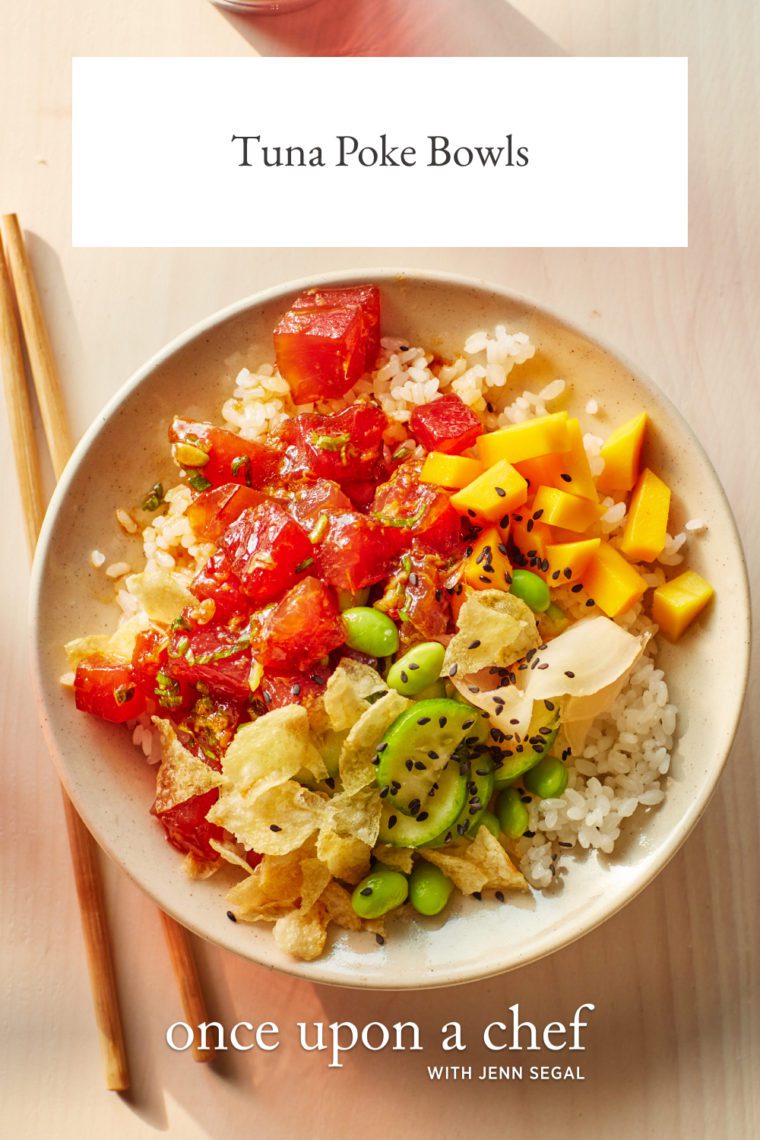
This post may contain affiliate links. Read my full disclosure policy.
Fresh, flavorful, and easy to pull together, this tuna poke bowl features fresh, sushi-grade ahi tuna tossed in a savory-sweet marinade, rice, and all your favorite toppings (crispy chips included).
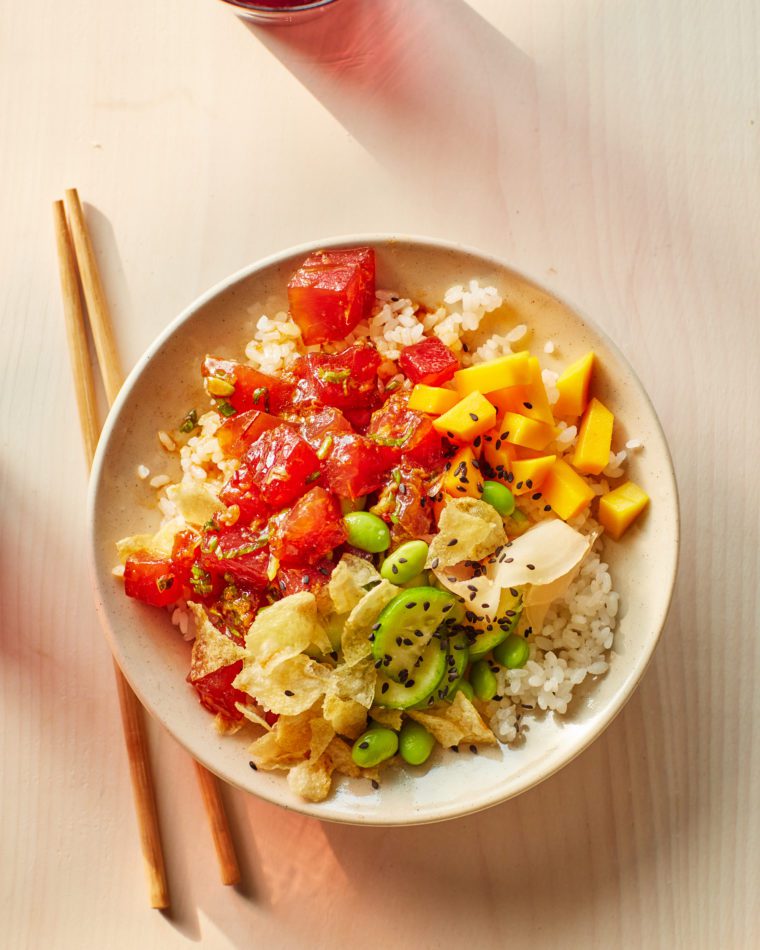
Photo by Johnny Miller (Clarkson Potter, 2021)
When you’re craving something light but still satisfying, a tuna poke bowl really hits the spot. It’s that mix of fresh ingredients and salty-umami flavors that makes it so irresistible. This version was inspired by a poke bowl I once had at a spa resort, made with marinated ahi tuna, sushi rice, crisp veggies, and crispy fried wontons on top.
To keep things easy for a weeknight, I usually swap the wontons for potato chips—a simple shortcut that still gives you that perfect salty crunch. Feel free to get creative with the toppings and use whatever you have on hand (or whatever you’re craving).
Bowls make hearty and satisfying meals served up in one dish! If you love this tuna poke bowl, try my beef hoisin bowls, egg roll in a bowl or chicken katsu bowls next.
“OMG! This was so good. I had it over brown rice with mango, avocado, pickled ginger and wonton strips…Thank you!”
Ahi Tuna Poke Bowl ingredients

- Sushi-Grade Ahi Tuna: Choose fresh sushi-grade yellowfin or bigeye tuna (both referred to as “ahi”), with a pink or reddish color. Just be sure not to buy Albacore tuna, which is the white tuna used to make canned tuna fish. Swap out the ahi tuna for another variety of sushi-grade fish if you prefer.
- Soy Sauce: For that signature umami flavor you expect in a poke bowl.
- Sesame Oil: Adds that signature nutty flavor to the poke dressing. It’s mixed with vegetable oil to keep it from overpowering the sauce — too much sesame oil can taste bitter. Most Asian recipes use dark (toasted) sesame oil, which has a much bolder flavor than the light variety.
- Honey: Adds a bit of sweetness to balance out the saltiness of the soy sauce and heat in the sambal oelek. It also gives a slight body to the sauce. You can also use brown sugar, though the flavor and texture are slightly different.
- Sambal Oelek: A mixture of chiles, brown sugar, and salt, it’s added to the sauce for a bit of heat. It can be found in the Asian section of most supermarkets and is sometimes labeled Chile Garlic Sauce. You can also use other chile sauces, such as sriracha or even add in some diced fresh chiles.
- Ginger and Scallions: Freshly grated ginger and scallions add aroma and flavor to the dish. If you’re new to cooking with fresh ginger, see my guide on how to grate fresh ginger.
- Cooked Sushi Rice: The base of every good poke or sushi bowl, sushi rice is a short grain rice with a sticky texture that makes it different from other varieties of rice. Make sure to follow the directions for cooking it, as it cooks slightly different than long grain rice.
- Toppings: This is where you can make your poke bowl your own. I like avocado, cucumber, edamame, pickled ginger, diced mango, wonton crisps/potato chips, and sesame seeds, but you can mix it up with thin red bell pepper strips, carrots, or cabbage. Try pickled red onions, sprinkle on furikake or nori, add a little heat with wasabi or fresh chiles, or drizzle on a creamy sauce like sriracha mayo.
- Jump to the printable recipe for precise measurements
How To Make a Tuna Poke Bowl
Step 1: Make the Marinade. Whisk together the soy sauce, vegetable oil, sesame oil, honey, sambal oelek, ginger, and scallions in a medium bowl.

Step 2: Combine with Fish. Add the tuna to the marinade mixture and toss to fully coat all the fish. Place the mixture in the fridge and allow it to marinate for at least 15 minutes or up to 1 hour. This step gives the fish time to absorb all the delicious flavors.
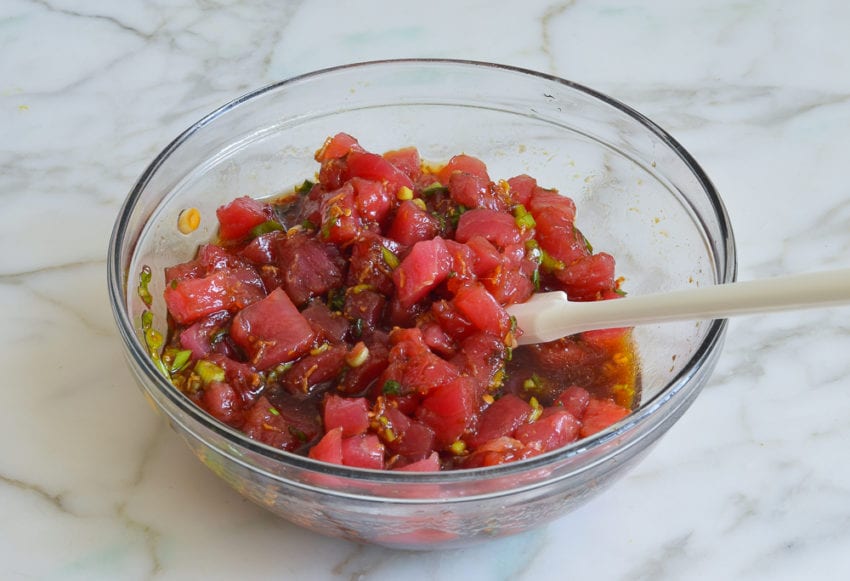
Step 3: Assemble and Serve. Scoop the rice into bowls and top with the tuna and your favorite toppings. Serve and enjoy!
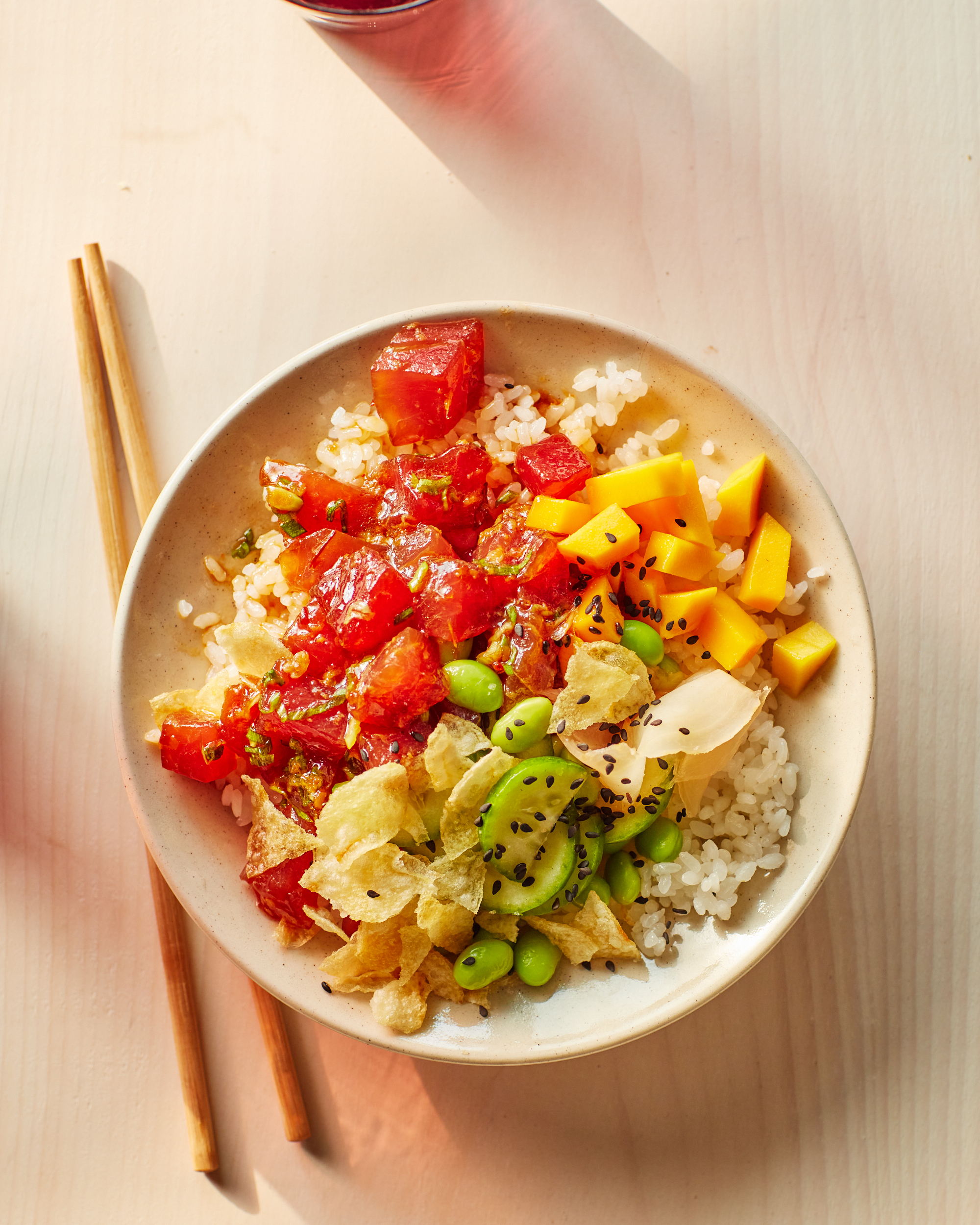
More Bowl Recipes You May Like
Tuna Poke Bowls

Big on flavor and simple to pull together, poke bowls make the perfect fresh, easy meal.
Ingredients
- ¼ cup + 2 tablespoons soy sauce
- 2 tablespoons vegetable oil
- 1 tablespoon sesame oil
- 2 tablespoons honey
- 1 tablespoon Sambal Oelek (see note)
- 2 teaspoons fresh grated ginger (see note)
- 3 scallions, white and green parts, thinly sliced
- 1 pound sushi-grade ahi tuna (such as yellowfin or big-eye tuna), diced into ¼ or ½-inch pieces
- 2 cups sushi rice, cooked according to package instructions (any other type of rice or grain can be substituted)
Optional Toppings
- Sliced avocado
- Sliced cucumber
- Edamame
- Pickled ginger
- Diced mango
- Wonton crisps or potato chips
- Sesame seeds
Instructions
- In a medium bowl, whisk together the soy sauce, vegetable oil, sesame oil, honey, sambal oelek, ginger, and scallions. Add the tuna and toss. Let the mixture sit in the fridge for at least 15 minutes or up to 1 hour.
- To serve, scoop rice into bowls, top with tuna poke and desired toppings. You will have extra sauce for drizzling over the toppings; serve on the side.
- Note: Sambal Oelek can be found in the Asian section of most supermarkets. It is sometimes labeled Chile Garlic Sauce.
- Note: Check out easy guidance on how to peel, grate, and chop fresh ginger here.
Nutrition Information
Powered by ![]()
- Per serving (Nutritional data does not include optional toppings -- 6 servings)
- Calories: 411
- Fat: 8 g
- Saturated fat: 1 g
- Carbohydrates: 59 g
- Sugar: 6 g
- Fiber: 0 g
- Protein: 24 g
- Sodium: 943 mg
- Cholesterol: 29 mg
This website is written and produced for informational purposes only. I am not a certified nutritionist and the nutritional data on this site has not been evaluated or approved by a nutritionist or the Food and Drug Administration. Nutritional information is offered as a courtesy and should not be construed as a guarantee. The data is calculated through an online nutritional calculator, Edamam.com. Although I do my best to provide accurate nutritional information, these figures should be considered estimates only. Varying factors such as product types or brands purchased, natural fluctuations in fresh produce, and the way ingredients are processed change the effective nutritional information in any given recipe. Furthermore, different online calculators provide different results depending on their own nutrition fact sources and algorithms. To obtain the most accurate nutritional information in a given recipe, you should calculate the nutritional information with the actual ingredients used in your recipe, using your preferred nutrition calculator.
Gluten-Free Adaptable Note
To the best of my knowledge, all of the ingredients used in this recipe are gluten-free or widely available in gluten-free versions. There is hidden gluten in many foods; if you're following a gluten-free diet or cooking for someone with gluten allergies, always read the labels of your ingredients to verify that they are gluten-free.
See more recipes:
Comments
Add a Comment Cancel reply
This site uses Akismet to reduce spam. Learn how your comment data is processed.

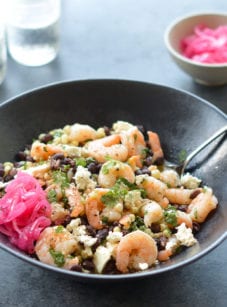

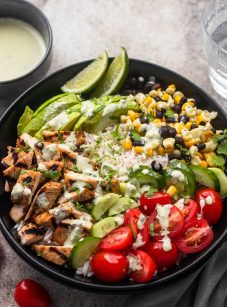

This recipe is absolutely delicious. I’m lucky that I can get fresh sushi grade tuna on a regular basis. I’ve served it the night I made it AND the next night, and the only difference was more intense flavor the second time. A personal note–I’m not a fan of ginger so I cut it in half, and it was still amazing. Also, when I made sushi rice, I added seasoned vinegar at the end, and this made the entire dish quite delicious. Yum!
I love your husband’s honesty. LOL hahaha
Can it be eaten next day too? Will the tuna still be ok?
Hi Jeanette, I think it really depends on how fresh the fish was when you purchased it (which you may not necessarily know). To be conservative, I’d air on the side of not eating it on the second day (also, it would get really salty by the second day as it continues to absorb the marinade).
My trick for eating it the next day, is to only add the amount of marinade to the portion of the tuna being eaten the night before, avoiding the over marinated scenario.
YUM, YUM, YUM. Another winner, Jen.
I made this tonight, and it was excellent! (as are all of Jenn’s recipes!) It was surprisingly quick and easy, and I will definitely be making again.
This recipe has a great flavor profile. It was a bit spicier than I was expecting. I have had poke bowls in restaurants that had less or no spice. As a result, I think this should be called Spicy Tuna Poke Bowl. When I make it again, I’ll certainly use the sriacha but probably a bit less.
Agreed!! So freaking spicy! Lol.
Really a delicious recipe! My family wolfed it down. I was suspicious about the honey but it balanced the flavors well. I served with mango, avocado, shaved cabbage, more chopped scallions, toasted coconut, and siracha mayo. Will definitely make this again and will try the potato chips on top too!
Do you serve it warm rice or cold ?
Hi Christine, I would eat it cold. Hope you enjoy!
Will it work with salmon?
Yep!
I am from Hawaii and your recipe is spot-on authentic. The trick is getting the fresh, raw ahi.
Unfortunately, I cannot each sushi, sashimi or poke as often as I would like. Now that the West has discovered the joy of raw game fish (marlin, tuna), we are eating the creatures to extinction.
Could you please tell me where to enter the contest for the cutting board? The page says to enter below, but there isn’t any place to enter or I am not seeing it. Thank you